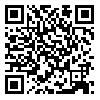سه شنبه 14 مرداد 1404
چکیده: (52 مشاهده)
Background and Objective: The tailoring profession, due to its unique nature, is associated with various ergonomic hazards that can lead to the development of occupation-related musculoskeletal disorders (OMSD). These disorders, being among the predominant causes of occupational disability, not only diminish individuals' quality of life but also exert a substantial economic strain on societal healthcare systems. Effective prevention necessitates a comprehensive evaluation of the workstation. This study aimed to conduct an ergonomic assessment to ascertain the prevalence of musculoskeletal disorders (MSDs) and their association with workplace posture and tenure among female tailors in Isfahan city.
Materials and Methods: In this cross-sectional descriptive study, a cohort of 40 female tailors, averaging 40.45 years in age and possessing an average work experience of 16.65 years, underwent evaluation. Musculoskeletal disorders were assessed utilizing the Nordic Questionnaire, while work experience was gauged through a dedicated questionnaire. Work-related posture was scrutinized employing the Rapid Entire Body Assessment (REBA) test. Statistical analysis entailed employing the Spearman correlation test at a significance threshold of 0.05 to elucidate associations among the study variables.
Findings: The prevalence of occupation-related musculoskeletal disorders was highest in the low back (92.5%), followed by the neck (62.5%), shoulder (57.5%), scapula and knee (45%), elbow and pelvic (27.5%), wrist (25%), and ankle (15%). A significant inverse correlation was observed between OMSDs in the low back and work experience (p = 0.028), while significant positive correlations were found between OMSDs in the low back (p = 0.009) and ankle (p = 0.036) and REBA scores.
Conclusion: The findings of this study indicate that the working postures of tailors require improvement. Interventions such as educating tailors about the risks of poor posture, providing training on proper posture during work, scheduling work breaks, and implementing appropriate corrective exercises and stretching are necessary.
Materials and Methods: In this cross-sectional descriptive study, a cohort of 40 female tailors, averaging 40.45 years in age and possessing an average work experience of 16.65 years, underwent evaluation. Musculoskeletal disorders were assessed utilizing the Nordic Questionnaire, while work experience was gauged through a dedicated questionnaire. Work-related posture was scrutinized employing the Rapid Entire Body Assessment (REBA) test. Statistical analysis entailed employing the Spearman correlation test at a significance threshold of 0.05 to elucidate associations among the study variables.
Findings: The prevalence of occupation-related musculoskeletal disorders was highest in the low back (92.5%), followed by the neck (62.5%), shoulder (57.5%), scapula and knee (45%), elbow and pelvic (27.5%), wrist (25%), and ankle (15%). A significant inverse correlation was observed between OMSDs in the low back and work experience (p = 0.028), while significant positive correlations were found between OMSDs in the low back (p = 0.009) and ankle (p = 0.036) and REBA scores.
Conclusion: The findings of this study indicate that the working postures of tailors require improvement. Interventions such as educating tailors about the risks of poor posture, providing training on proper posture during work, scheduling work breaks, and implementing appropriate corrective exercises and stretching are necessary.
| بازنشر اطلاعات | |
 |
این مقاله تحت شرایط Creative Commons Attribution-NonCommercial 4.0 International License قابل بازنشر است. |



